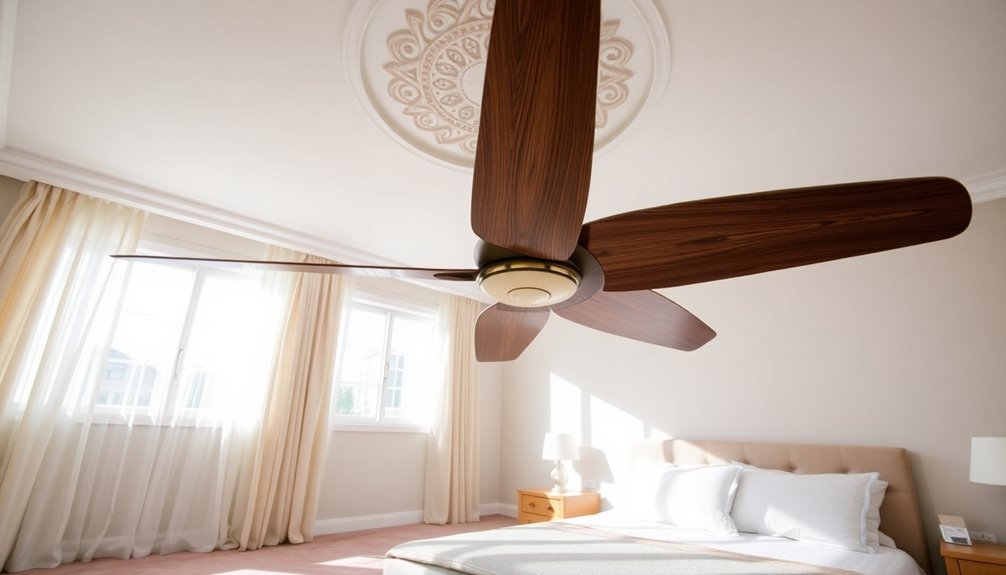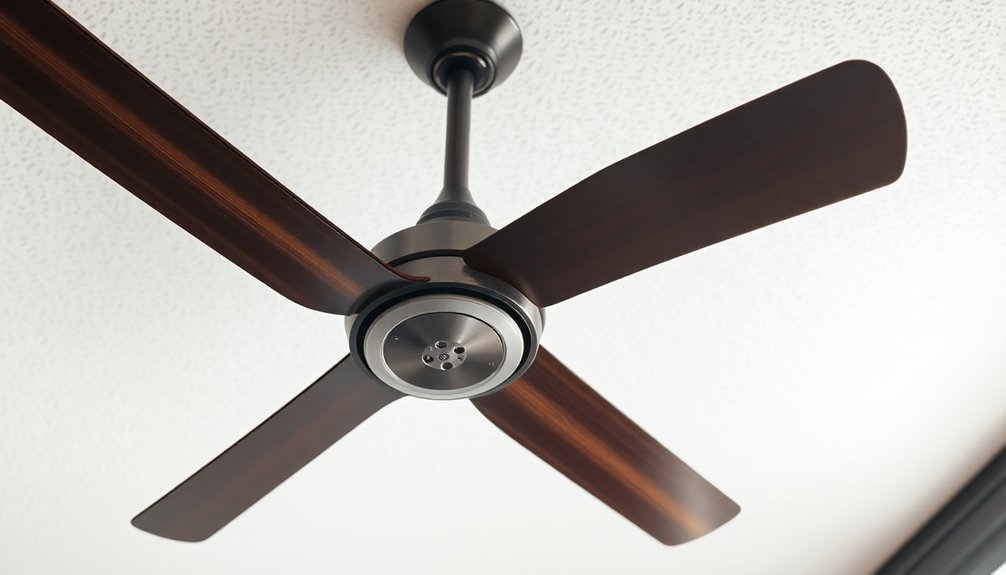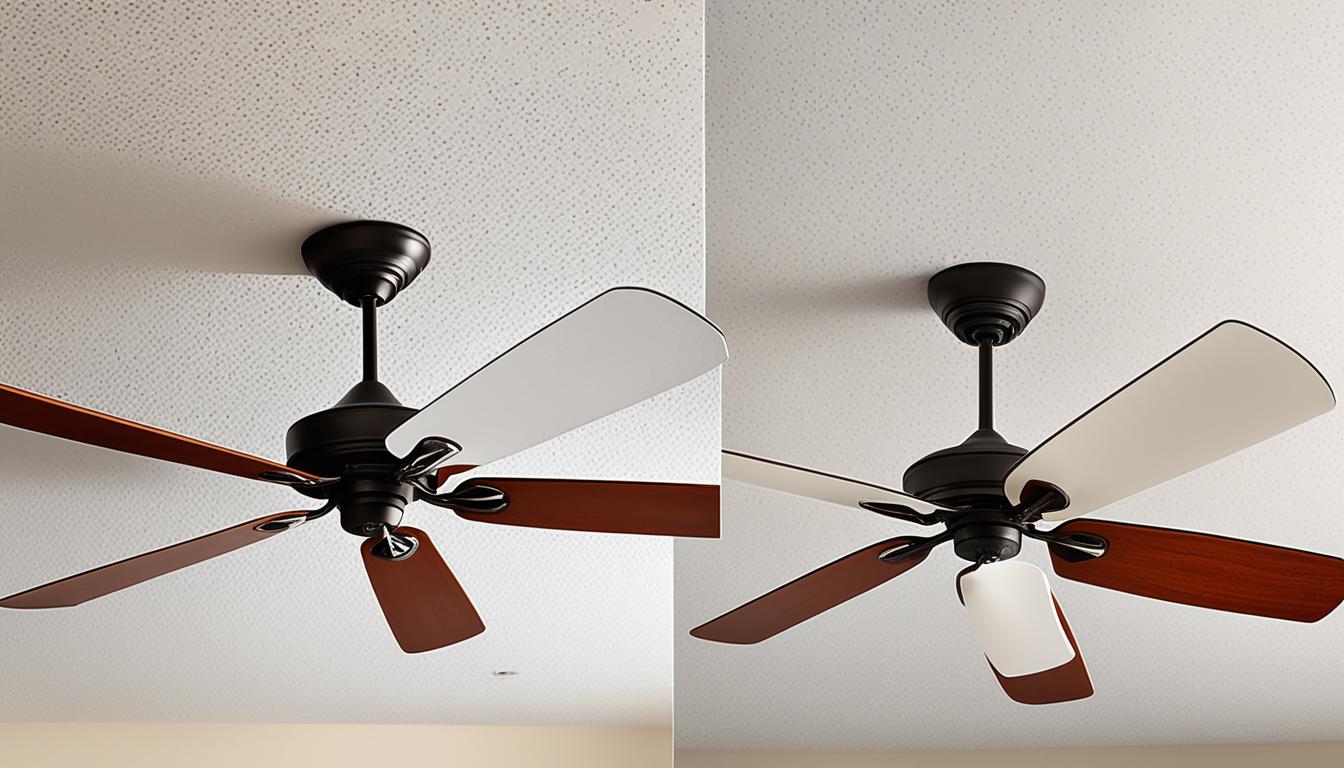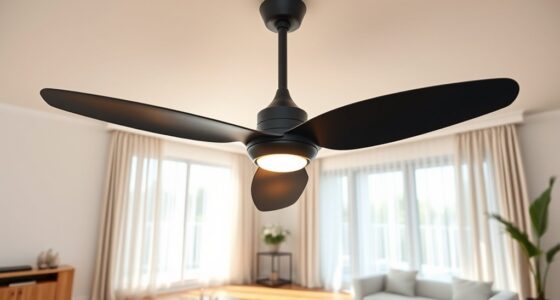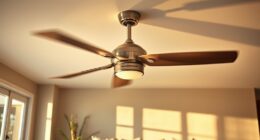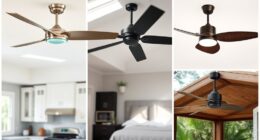To choose the right ceiling fan for your bedroom, measure your room size first. For rooms up to 144 sq. ft., a fan with a blade span of 44 to 50 inches is ideal. If your room is between 144 and 225 sq. ft., aim for a fan with a blade span of 50 to 54 inches. Consider the fan's CFM rating too, as you'll want a range of 1,600 to 4,500 CFM for effective cooling. Proper installation height and accessories can further enhance performance. Stick around to explore tips on maximizing fan efficiency and comfort.
Key Takeaways
- For rooms up to 144 sq. ft., choose a ceiling fan with a blade span of 44 to 50 inches for optimal airflow.
- For bedrooms between 144 to 225 sq. ft., select a fan with a blade span of 50 to 54 inches.
- Measure your room by multiplying its length by width to determine total square footage before selecting a fan.
- Look for ceiling fans with CFM ratings between 1,600 to 4,500 for effective cooling in larger bedrooms.
- Properly sized fans enhance energy efficiency and comfort while preventing overwhelming small spaces with oversized units.
Room Size and Fan Size

When it comes to choosing the right ceiling fan for your bedroom, the size of the room plays an essential role. For rooms up to 144 square feet, you should look for ceiling fan sizes with a blade span of 44 to 50 inches. This range guarantees ideal airflow and comfort without overwhelming the space.
If your bedroom is between 144 and 225 square feet, a fan with a blade span of 50 to 54 inches is ideal to maintain sufficient air circulation.
To determine the right fan size, you'll want to measure your room accurately. Multiply the length by the width to find the total square footage. This measurement helps you select a fan that fits your needs perfectly.
Airflow and CFM Ratings

Airflow and CFM ratings are vital factors to take into account in guaranteeing your bedroom stays comfortable. CFM, or Cubic Feet per Minute, measures how much air a ceiling fan can move. For effective cooling, especially in larger bedrooms, you'll want a fan with a CFM rating between 1,600 to 4,500. This range guarantees adequate airflow, which is essential during warmer months.
When choosing a ceiling fan size for a bedroom of 144 to 225 square feet, a medium fan with a blade span of 44-50 inches is typically recommended.
But don't just focus on the size; the CFM ratings can vary considerably among fans with the same blade span. This makes it vital to compare these values to find the best option for your needs.
Proper airflow from your ceiling fan can enhance your comfort by improving air circulation, allowing for a more energy-efficient cooling experience.
Blade Span Considerations

When choosing a ceiling fan, the blade span is key to achieving ideal airflow and comfort in your bedroom.
You'll want to match the fan's size to your room's dimensions for the best performance and aesthetic appeal.
Understanding airflow patterns will help you select the right blade length for your specific needs.
Optimal Blade Length
Choosing the right blade length for your ceiling fan can greatly enhance your comfort and energy efficiency. The ideal blade span helps you achieve a balance between airflow and energy use, making it essential to select the right size for your bedroom.
Here's what to take into account:
- Room Size: For bedrooms up to 144 square feet, aim for a blade span of 44 to 50 inches.
- Larger Spaces: For rooms between 144 to 225 square feet, a blade span of 50 to 54 inches is ideal.
- Small Rooms: If your bedroom is under 100 square feet, a 36-inch blade span will provide adequate airflow.
- CFM Rating: Remember, larger blades typically produce a higher CFM rating, ensuring better air movement.
In addition to enhancing your comfort, having a fan with the ideal height and blade length can increase energy efficiency. A well-fitted ceiling fan helps in maintaining a consistent airflow, potentially lowering your energy bills while keeping the room cool.
Moreover, selecting ceiling fans with optimal airflow characteristics can further improve your bedroom's climate control.
Airflow Patterns Explained
Understanding your ceiling fan's blade span is vital for optimizing airflow patterns in your bedroom. The blade span, which measures the distance from tip to tip of the blades, directly influences how air circulates in the room. A fan with a blade span of 44 to 50 inches is typically recommended for bedrooms between 144 to 225 square feet, ensuring adequate air movement.
Larger blade spans create a broader airflow pattern, allowing the fan to effectively circulate air across the entire space. This airflow pattern resembles a descending cone, ensuring that air reaches all corners without creating uncomfortable drafts.
Selecting the right blade span is important; fans that are too small may not provide the necessary airflow, while those that are too large can overwhelm the room and lead to uncomfortable conditions.
To enhance comfort and thermal efficiency, aim for a ceiling fan that matches your bedroom size and airflow needs. This way, you can enjoy a pleasant atmosphere tailored to your preferences, all while maximizing the benefits of your ceiling fan's design.
Room Size Matching
Matching the size of your ceiling fan to your bedroom dimensions is essential for achieving ideal airflow and comfort.
Choosing the right fan size based on your room size helps guarantee effective air circulation. Here's a quick guide to help you select the perfect blade span:
- Up to 100 square feet: A 36-inch ceiling fan is perfect for smaller spaces, providing adequate circulation without overwhelming the room.
- Up to 144 square feet: Opt for a fan with a blade span of 44 to 50 inches for effective airflow.
- 144 to 225 square feet: Look for a fan with a blade span of 50 to 54 inches to maintain peak comfort.
- Over 225 square feet: Choose a fan with a blade span of 52 inches or more to guarantee efficiency in larger bedrooms.
Accurate measurement of your room size is vital, as the proper blade span directly influences airflow and overall comfort in your space.
Mounting Options and Height

When it comes to installing a ceiling fan in your bedroom, selecting the right mounting option and height is vital for ideal airflow and safety. The ideal height from the floor to the blades should be approximately 8 feet. This guarantees effective airflow while avoiding any collisions with people.
If your ceiling height is under 8 feet, opt for a flush mount or hugger fan. These fans sit closer to the ceiling, maximizing headroom.
For ceilings between 8 to 9 feet, you'll typically need a downrod to create the proper clearance for airflow. Downrods come in various lengths, ranging from 12 to 72 inches, so you can choose one that best fits your needs.
Remember that a minimum clearance of 7 feet from the floor to the fan blades is vital for comfort and safety.
If you're dealing with angled ceilings, consider using an angled-ceiling adapter. This will help you achieve the correct mounting angle and height for peak fan performance.
Design and Aesthetic Appeal

A ceiling fan can be a striking focal point in your bedroom, seamlessly blending functionality with style. To enhance your space, consider these four key factors:
- Fan Size: Verify the fan size fits your room. A properly sized fan maintains balance, avoiding a cramped or empty look.
- Blade Colors: Choose blade colors that harmonize with your decor. Whether you prefer sleek metallics or warm wood finishes, the right choice can elevate your room's aesthetic.
- Number of Blades: The number of blades affects both style and airflow. More blades create a softer appearance, while fewer blades offer a bold statement.
- Integrated Lighting: Look for fans with integrated lighting. They provide illumination and style, making them a practical and chic addition to your bedroom.
Efficiency and Energy Savings

Although you mightn't think of a ceiling fan as a considerable contributor to energy efficiency, selecting the right one can lead to noticeable savings on your utility bills.
Properly sized ceiling fans for your bedroom can greatly improve airflow, allowing you to set your thermostat a bit higher in the summer and lower in the winter, reducing reliance on HVAC systems. Look for fans with a CFM (Cubic Feet per Minute) rating between 1,600 and 4,500 for bedrooms sized between 144-225 square feet. This range enhances air circulation and comfort. Additionally, regular maintenance of your ceiling fan can help ensure optimal performance and efficiency. Commercial grade heat pumps can also complement your ceiling fan's effectiveness by maintaining a consistent indoor temperature, which contributes to energy savings throughout the year. Regular maintenance of the heat pump can enhance the efficiency of the refrigeration cycle by up to 70% efficiency.
In winter, reversing the fan's direction helps distribute warm air more evenly, potentially lowering your heating costs by up to 10%.
Additionally, consider energy-efficient ceiling fans with DC motors, which consume up to 70% less energy than traditional AC motors. This can considerably lower your electricity bills over time.
By maintaining your fan and ensuring it's properly sized, you could see a reduction of up to 30% in cooling costs during the summer months. Modern Energy Star certified fans can even raise the thermostat temperature by 4°F, further enhancing your energy savings.
Investing in the right ceiling fan not only adds comfort but also boosts your home's energy efficiency.
Installation Tips and Accessories

When installing your ceiling fan, it's vital to use proper mounting techniques and essential tools to guarantee safety and efficiency.
You'll also want to take into account recommended accessories that can enhance functionality, like light kits or remote controls.
Keeping these points in mind will help you achieve peak performance and comfort in your bedroom.
Proper Mounting Techniques
To guarantee your ceiling fan operates efficiently and safely, it's crucial to follow proper mounting techniques. Here are some key tips to keep in mind:
- Height Matters: Verify the fan blades are at least 7 feet from the floor and 8 to 10 inches from the ceiling for ideal air circulation.
- Choose the Right Mount: Use a flush mount for ceilings under 8 feet. For ceilings over 9 feet, opt for a downrod ceiling fan, selecting a downrod length that keeps the fan at 8 feet from the floor.
- Secure Mounting: Always confirm that you're using suitable mounting hardware attached to a fan-rated electrical box to safely support the fan's weight.
- Consider Angled Ceilings: If your ceiling is sloped, use an angled-ceiling adapter to make sure the fan hangs level, enhancing both airflow and aesthetic appeal.
Additionally, think about including accessories like remote controls or pull chains, especially in larger bedrooms, to make operating the fan more convenient.
Following these techniques will guarantee your ceiling fan is mounted correctly and operates effectively.
Essential Installation Tools
Once your ceiling fan is properly mounted, having the right tools on hand makes the installation process smoother and safer. To install a ceiling fan effectively, you'll need a few indispensable tools.
A ladder is vital for safely reaching the ceiling height and accessing the fan's components. A screwdriver is necessary for securing the fan to the mounting bracket, while a wire stripper helps you prepare the electrical connections.
Using a stud finder is invaluable when installing a ceiling fan; it enables you to locate ceiling joists for secure mounting, preventing any wobbling or potential detachment.
Before you start, make sure to use a voltage tester to confirm that the power is off. This step minimizes the risk of electric shock, allowing you to work confidently.
Finally, don't forget to have electrical tape handy. It's essential for securing wire connections and enhancing overall safety during the installation process.
With these essential tools, you'll be well-equipped for installing a ceiling fan that not only looks great but functions effectively in your bedroom.
Recommended Accessories Options
Choosing the right accessories can markedly enhance your ceiling fan's performance and style in the bedroom. Here are some recommended options you should consider:
- Light Kit: Installing a light kit with your fan not only provides illumination but also improves airflow, making your bedroom more functional.
- Remote Control: A remote control adds convenience, letting you adjust your fan settings from the comfort of your bed.
- Downrod Length: Select a downrod length that matches your ceiling height. For instance, a downrod of 12 inches is typically recommended for 10-foot ceilings to guarantee ideal airflow.
- Wall Plate: A wall plate that complements your fan's finish can enhance the overall aesthetic of your room, creating a cohesive look.
If you have a sloped ceiling, consider using an angled-ceiling adapter to guarantee proper installation and airflow.
Frequently Asked Questions
What Is the Best Size Ceiling Fan for a Bedroom?
When you're choosing the best size ceiling fan for your bedroom, consider the room's square footage.
For spaces up to 100 square feet, a fan with a blade span of 29 to 36 inches works well.
If your bedroom is 144 to 225 square feet, aim for 44 to 50 inches.
Larger rooms over 225 square feet need fans with at least a 52-inch span.
Always hang the fan at least 7 feet above the floor for ideal airflow.
Is a 52 Inch Fan Too Big for a 12X12 Room?
Yes, a 52-inch fan is generally too big for a 12×12 room.
You'd want to choose a fan with a blade span between 36 to 50 inches for ideal comfort and airflow.
A fan that's too large can create uncomfortable turbulence and overwhelm the space, making it less functional.
Is a 60 Fan Too Big for a Bedroom?
Imagine your bedroom as a serene oasis—don't let a too-large ceiling fan disrupt that tranquility!
A 60-inch fan could overwhelm smaller spaces, making them feel cramped and uncomfortable. If your room's under 225 square feet, you'll likely benefit from a smaller fan to enhance airflow without cluttering the aesthetic.
Always consider the room size and fan CFM rating; it's key to maintaining both comfort and energy efficiency in your sanctuary.
Is a 44 Inch Fan Too Small for a Bedroom?
A 44-inch fan might be too small for your bedroom if it exceeds 144 square feet.
You'll want adequate airflow to stay comfortable, and a fan that's too small can lead to hot spots and increased energy costs.
If your room is larger, consider a fan with a blade span of 44 to 50 inches.
Pay attention to your room layout and ceiling height, as these factors also influence airflow effectiveness.
Conclusion
Choosing the right ceiling fan for your bedroom is like finding the perfect partner—it's all about balance and compatibility. By considering your room size, airflow needs, and design preferences, you'll create a space that feels as invigorating as a gentle summer breeze. Remember, a well-chosen fan not only enhances comfort but also adds style and energy efficiency to your sanctuary. So go ahead, let the blades of your new fan whirl into your dream space!
